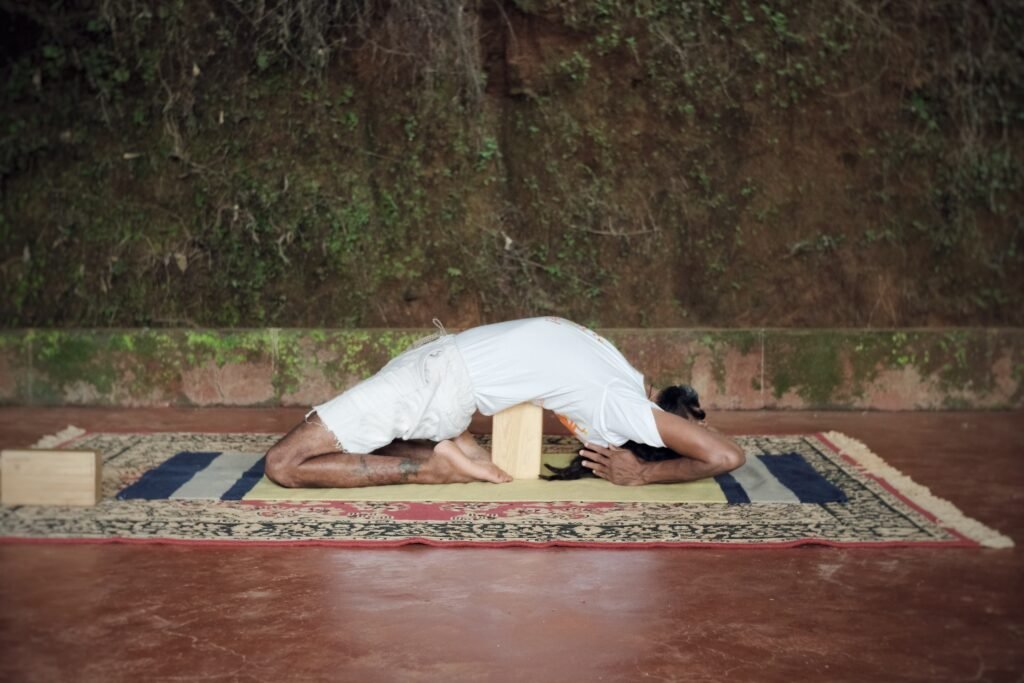In Sanskrit, “Kapota” means “Pigeon,” and “Asana” means a seat, pose, or posture. The pigeon pose, or kapotasana, is classified as medium-level. This is the best pose because it strengthens the back and crotch while also opening up the midsection (chest). It strengthens the back, lengthens the thighs and crotch, increases flexibility, and opens the hips area (Groin)
Pigeon Pose, or Kapotasana, is a full-body exercise. It improves the condition of your abdominal region and legs. People suffering from foot problems with negative effects will find it especially helpful.
This stance helps to loosen up tight hip flexors and thighs while conditioning your thighs.

Different Ways to Try Pigeon Pose
VARIATIONS OF PIGEON POSE
Not everyone can fold up like an origami bird, but the pigeon pose is an excellent stretch for your hips and lower back. Additionally, straining your knees, ankles, or hips by forcing yourself into the pose can be harmful. Try these variations to increase your range of motion securely and efficiently.
Reclining Figure-4 Pose
This Pigeon Pose variation dramatically reduces the pressure on the front leg by turning the shape upside down.
- Your feet should be flat on the floor as you lay on your back with your knees bent.
- Flex your right ankle and form a figure-4 with your right ankle crossed over your left knee.
- Alternatively, you can stand up by lifting your left foot off the ground.
- Either interlace your fingers or loop a strap behind your left thigh.
- Lengthen your right knee away from your body while gently pulling your left leg toward your body.
- Lower your pelvis toward the floor to create opposing energy in all directions.
- Before switching sides, hold for a few long, deep breaths.
Seated Pigeon Pose
Instead of letting gravity decide the depth of the pose for you, this Pigeon Pose variation lets you control it.
- Put your feet flat on the ground and sit down on the floor with your knees bent.
- Lean your weight into your hands and place your hands behind your hips.
- Make a figure-four with your right foot by crossing your right ankle over your left knee.
- Alternatively, you can stand up to your fingertips and press your fingers firmly into the ground to lengthen your spine.
- Boost your chest and move your heart toward your right shin.
- To heighten the sensations of the pose, you can either remain in your current position or move your seat closer to your left ankle.
- Before switching sides, hold for a few long, deep breaths.
Forward Fold in Deer Pose (Mrigasana)
Except for one glaring difference—a bent back leg—the deer Pose is a shape from the yin tradition that resembles Pigeon Pose in many ways.
- Kneel on the floor with your feet flat on the surface and separated by the width of your mat.
- Release both knees toward the right side of your mat without moving your feet so that your left leg forms a 90-degree angle at your side and your right leg forms a 90-degree angle in front of you.
- Options include remaining upright with your torso raised or bending forward as far as you can comfortably go over your right shin.
- You have the choice to release your entire torso to the floor, lower to your forearms, or place props under your torso to support your weight.
- Before switching sides, hold for a few long, deep breaths.
Elevated Pigeon Pose
The traditional Sleeping Pigeon Pose calls for a substantial forward fold.
In this elevated variation, you can maintain your upright posture to achieve an outer hip stretch that is more of a backbend than a forward fold.
- Beginning on all fours, stack your shoulders over your wrists and your hips over your knees in the Tabletop Pose.
- Swing your right ankle as far as you can comfortably toward your left wrist after sliding your right knee forward to the outside of your right wrist.
- If it is comfortable for you to go, slide your left knee toward the back of your mat.
- Release your hip weight onto your choice prop(s), such as a thick blanket, pillow, yoga block, or bolster.
- Release your fingertips or hands from either side of your hips and position your prop(s) to support you comfortably.
- To lengthen your spine, lift your pubic bone subtly toward your navel, open your chest, and root down into your fingertips or hands.
- Before switching sides, hold for a few long, deep breaths.
Resting Pigeon Pose
If you’re looking for a deeper, more yin variation of the pigeon pose, try the resting pigeon or extended one-legged pigeon pose.
- Lengthen your spine in the traditional pigeon pose before folding over your front leg.
- Here, you can place blocks or cushions for your forehead to rest on or lower it to the mat.
- Your arms are spread out on the mat with your hands resting by your head or stretched overhead.
Revolved Pigeon Pose
The twisting motion of the spine in the revolved pigeon pose is ideal for relaxing the back muscles and releasing tension.
- Put your left hand in front of your right shin in the middle of your mat while in the traditional pigeon pose with your right leg forward.
- Turn your torso to the right, starting from your hips while holding the side of your waist, hip, or right big toe with your right arm around your back.
- Exhale to twist slightly more, and inhale to lengthen your spine.
